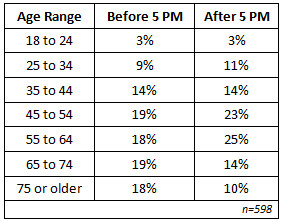An intercept survey is a research method used to gather on-site feedback from an audience. Intercept surveys are often used at events, restaurants, conferences, and in shopping malls to collect patron perception information. During an intercept survey, the interviewer may approach a patron to ask about their experience at the event, facility or restaurant. Results from the intercept surveys allow the client organization to obtain feedback from their target audience while the information is still fresh in their minds. Below are three tips when preparing for an intercept survey project.

Keep It Short
Intercept survey respondents are typically “on-the-go.” They may be going to purchase something at a concession stand during halftime, or leaving the facility after the event. To ensure the research company and end client is represented in a positive fashion, it’s important for the intercept survey to be short. At RMS, whenever possible we try to ensure the intercept survey is around 5 minutes or less. A great market research firm will be knowledgeable in survey creation techniques and constructing creative questions in order to obtain the maximum amount of information in a short amount of time.
Be Flexible
Depending upon the respondent’s comfort level with technology, the interviewer may complete the survey for the respondent, or provide them with a tablet to complete on their own. It’s important for interviewers to be equipped with the proper equipment when conducting intercept surveys. In our experience, tablets work best, and allow the interviewer to adapt to the survey environment. For example, we’ve learned that in a stadium, Wi-Fi reception may be spotty and our interviewers need to be equipped with wireless hot spots to ensure they have access to the internet in order to connect to the digital survey. To make sure we are always flexible with our environment, we also have an offline survey option which allows our interviewers to collect survey responses without needing the internet to save them.
Make it Worth Their While
Over the years we have found that even a small incentive has a positive impact on the intercept survey response rate. The bottom line is – make it worth their while. It doesn’t need to be expensive. We have had great success in offering rewards such as a $2.50 coffee shop gift card, credits for a free movie rental or Amazon purchase, or a coupon for a free drink or food item at the venue where the surveys are being conducted. When providing an incentive, it’s also important to consider the timing of the intercept survey as it relates to the incentive. For example, if you’re distributing a coupon for a free beverage at a football stadium, it would be best to conduct the intercept interviews around halftime rather than the end of the game. Enough time will have passed for patrons to provide their perception of the stadium and facilities, while also ensuring they still have time to use their free beverage coupon.
RMS is a full-service market research firm with a long history of conducting intercept surveys in a wide array of settings. If you are interested in learning more about our research capabilities, please contact Sandy Baker, our Senior Director of Business Development & Corporate Strategy at SandyB@RMSresults.com or by calling 1-866-567-5422. Visit our website at www.RMSresults.com.












